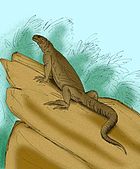
Agamidae is a family of over 550 species of iguanian lizards indigenous to Africa, Asia, Australia, and a few in Southern Europe. Many species are commonly called dragons or dragon lizards.
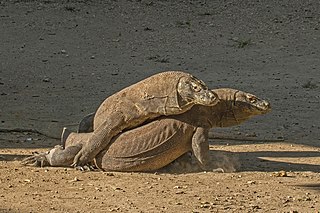
The Varanidae are a family of lizards in the superfamily Varanoidea and order Anguimorpha. The family, a group of carnivorous and frugivorous lizards, includes the living genus Varanus and a number of extinct genera more closely related to Varanus than to the earless monitor lizard (Lanthanotus). Varanus includes the Komodo dragon, crocodile monitor, savannah monitor, the goannas of Australia and Southeast Asia, and various other species with a similarly distinctive appearance. Their closest living relatives are the earless monitor lizard and chinese crocodile lizard. The oldest members of the family are known from the Late Cretaceous of Mongolia.

Mosasaurs comprise a group of extinct, large marine reptiles from the Late Cretaceous. Their first fossil remains were discovered in a limestone quarry at Maastricht on the Meuse in 1764. They belong to the order Squamata, which includes lizards and snakes.
Amazonsaurus is a genus of diplodocoid sauropod dinosaur from the Early Cretaceous Period of what is now South America. It would have been a large-bodied quadrupedal herbivore with a long neck and whiplash tail. Although more derived diplodocoids were some of the longest animals ever to exist, Amazonsaurus was probably not more than 12 meters (40 ft) long. Gregory S. Paul estimated in 2010 its weight at 5000 kg.
Unquillosaurus is a genus of possible maniraptoran or carnosaurian theropod dinosaur from the Late Cretaceous Los Blanquitos Formation of Salta Province, Argentina. The genus contains a single species, U. ceibalii, known only from a single fossilized pubis.

Pycnonemosaurus is a genus of carnivorous theropod dinosaur that belonged to the family Abelisauridae. It was found in the Upper Cretaceous red conglomerate sandstones of the Cachoeira do Bom Jardim Formation, Mato Grosso, Brazil, and it lived during the Campanian stage of the Late Cretaceous period.

Lirainosaurus is a genus of titanosaur sauropod which lived in what is now Spain. The type species, Lirainosaurus astibiae, was described by Sanz, Powell, Le Loeuff, Martinez, and Pereda-Suberbiola in 1999. It was a relatively small sauropod, measuring 4 metres (13 ft) long, possibly up to 6 metres (20 ft) long for the largest individuals, and weighed about 2–4 metric tons.

Sonidosaurus is a genus of sauropod dinosaur from the Late Cretaceous. It was a titanosaur which lived in what is now Inner Mongolia. The type species, Sonidosaurus saihangaobiensis, was described by Xu, Zhang, Tan, Zhao, and Tan in 2006. It was a small titanosaur, about 9 meters (30 ft) long. It was first discovered in the Iren Dabasu Formation in 2001 in a quarry which would later yield the remains of Gigantoraptor starting in 2005.
Brasiliguana is a genus of iguanian lizard which lived during the late Cretaceous period in what is now Brazil. It is known from the holotype MN 7230-V, an isolated left maxilla with partially preserved teeth, which was found in the Upper Cretaceous Adamantina Formation, part of the Bauru Group of São Paulo State, southeast Brazil. Brasiliguana was named by William R. Nava and Agustín G. Martinelli in 2011 and the type species is Brasiliguana prudentis. The generic name refers to its provenance from the Late Cretaceous of Brazil and iguana, from the South American and Caribbean aboriginal language meaning "lizard". The specific name, prudentis, refers to Presidente Prudente Municipality, where the holotype was found.
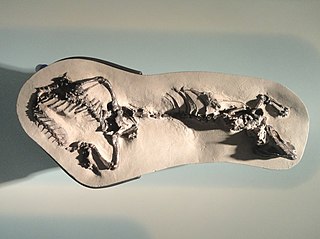
Polyglyphanodontia, also known as the Borioteiioidea, is an extinct clade of lizards from the Cretaceous that includes around a dozen genera. Polyglyphanodontians were the dominant group of lizards in North America and Asia during the Late Cretaceous. Most polyglyphanodontians are Late Cretaceous in age, though the oldest one, Kuwajimalla kagaensis, is known from the Early Cretaceous Kuwajima Formation (Japan). Early Cretaceous South American taxon Tijubina, and possibly also Olindalacerta, might also fall within Polyglyphanodontia or be closely allied to the group, but if so, they would be two of only four Gondwanan examples of an otherwise Laurasian clade. They produced a remarkable range of forms. Chamopsiids, including Chamops, were characterized by large, blunt, crushing teeth, and were most likely omnivores. Polyglyphanodon, from the Maastrichtian of Utah, was another herbivore, but its teeth formed a series of transverse blades, similar to those of Trilophosaurus. Peneteius had remarkable, multicusped teeth, similar to those of mammals. The polyglyphanodontids first appear in the latter part of the Early Cretaceous in North America, and became extinct during the Cretaceous-Paleogene extinction event. Polyglyphanodontians closely resembled the teiid lizards, and purported teiid lizards from the Late Cretaceous appear to be polyglyphanodontians. The only species known to have survived the Cretaceous was Chamops, which survived until the very early Ypresian.
Arcanosaurus is an extinct genus of varanoid lizard from the Early Cretaceous of Spain. It is known from 29 vertebrae that were found disarticulated but close together in a fossil locality called Viajete in the province of Burgos. The bones were found within a layer of the Castrillo de la Reina Formation, which dates back to the late Barremian and early Aptian stages of the Early Cretaceous. The vertebrae of Arcanosaurus share several features in common with those of other varanoid lizards, but they lack bony projections called posterior hypapophyses that are found in nearly all other varanoids.
Normanniasaurus is an extinct genus of basal titanosaur sauropod known from the Early Cretaceous Poudingue Ferrugineux of Seine-Maritime, northwestern France.
Gueragama is an extinct genus of iguanian lizard from the Cretaceous of Brazil. It belongs to a group of iguanians called Acrodonta, whose living members include chameleons and agamids and are currently restricted to the Old World. Gueragama is the only acrodont known from South America, providing evidence that the group once ranged across much of Gondwana and only became restricted to the Old World after the supercontinent broke apart. The type species, Gueragama sulamericana, was named in 2015 on the basis of an isolated lower jaw from Goio-Erê Formation in the Bauru Basin, which was deposited in a desert environment. Although description shows age of Formation at Turonian to Campanian, later study proposes age around Aptian to Albian instead. Unlike modern acrodontans, whose teeth implant on the margins of the jaws, Gueragama has teeth that implant along the inner surface of the lower jaw, a feature common in most non-acrodontan lizards and characteristic of the second major group of iguanians, Pleurodonta. The non-acrodont dentition of Gueragama is evidence of its basal position within Acrodonta, and is shared with the taxon of Late Cretaceous acrodontan relatives, the family Priscagamidae.
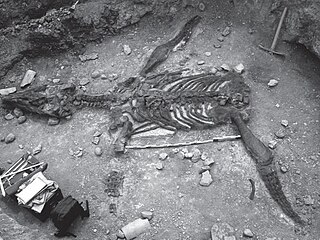
Stenorhynchosaurus is an extinct genus of pliosaurid plesiosaurs which lived in the Early Cretaceous of South America. The type species and only known is Stenorhynchosaurus munozi. It was a medium-sized pliosaur, reaching an adult body length of 7 m (23 ft).
Chamops is an extinct genus of polyglyphanodontian lizard from the Late Cretaceous-Early Eocene of North America. Fossils have been found in the Hell Creek Formation, Judith River Formation and Polecat Bench Formation of Montana, the Milk River Formation of Alberta, Canada and possibly also the Laramie Formation of Colorado. It is known from only one species, C. segnis. Chamops grew to approximately 0.5 meters long, and 2 kilograms in weight. Unlike other polyglyphanodonts, Chamops had a more blunt snout. Chamops belonged to the Chamopsiid family of polyglyphanodonian lizards that lived in the Northern Hemisphere during the Late Cretaceous, although there are some possible Chamopsiid genera from South America and the Kem Kem Bone Beds in Morocco. It was originally thought Chamops and kin are related to whiptails, although it is now thought they are more closely related to iguanas.
Oardasaurus is an extinct genus of lizard from the latest Cretaceous of Romania. It is a member of the Barbatteiidae, a group of lizards closely related to the Teiidae. At 20 centimetres (7.9 in) in length, it was much smaller than the only other named member of the Barbatteiidae, Barbatteius, which lived slightly later. Like Barbatteius, Oardasaurus can be identified by the presence of a crust of bone deposits, or osteoderms, on the roof of its skull; it differs from Barbatteius in the pattern of the sculpturing on this crust. Both Oardasaurus and Barbatteius lived in the isolated island ecosystem of Hațeg Island, having rapidly diversified into various generalist predators of small prey after their arrival on the island during the Early Cretaceous. They went extinct in the Cretaceous–Paleogene extinction event.
Meyasaurus is an extinct genus of Teiid lizard known from the Barremian of Spain and the Isle of Wight, UK. Four species are known from Spain, from the La Huérguina, Camarillas, and La Pedrera de Rúbies Formations while an indeterminate taxon is known from the Wessex Formation of Isle of Wight. It is a possible close relative of Barbatteius and other members of Barbatteiidae.

Berthasaura is a genus of noasaurid ceratosaurian theropod dinosaur from the Cretaceous Goio-Erê Formation of Paraná, Brazil. The type and only species is Berthasaura leopoldinae.
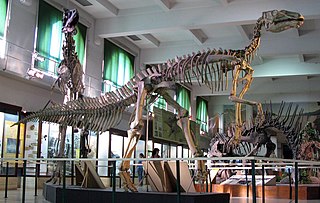
Huallasaurus is an extinct genus of saurolophine hadrosaur from the Late Cretaceous Los Alamitos Formation of Patagonia in Argentina. The type and only species is H. australis. Originally named as a species of Kritosaurus in 1984, it was long considered a synonym of Secernosaurus before being recognized as its own distinct genus in a 2022 study, different from other members of Kritosaurini.
Transylvanosaurus is an extinct genus of rhabdodontid ornithopod dinosaur from the Late Cretaceous (Maastrichtian) Hateg Basin of Romania. The type species is Transylvanosaurus platycephalus, known from a fragmentary skull.










